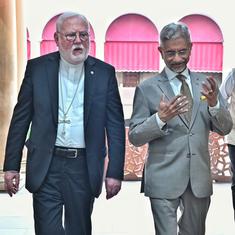India has one of the highest levels of traffic-related deaths in the world. In 2023, an estimated 1.6 lakh Indians were killed in road accidents, according to an official report.
Unsafe road conditions, the neglect of pedestrian safety as well as the increasing influx of motor vehicles onto India’s roads are among the major factors that contribute to this situation. At the same time, India severely lacks critical and emergency medical services that could prove to be the difference between life and death.
It is well established that about 50% of road crash deaths can be averted if victims receive definitive medical care within the first hour.
India’s network of ambulance services could play a key role here, but it falls short on several counts. It is disorganised, lacks adequate equipment and trained staff, and has poor regulatory mechanisms.
Unsafe roads, high fatalities
In 2022, the Ministry of Road Transport and Highways recorded 4.6 lakh road crashes that left 4,43,366 people injured and resulted in 1,68,491 deaths. About 66.5% of these deaths were of adults between the ages of 18 and 45.
This translates to 53 road crashes leading to 19 deaths every hour in India.
Road deaths among those aged under 18 increased by 22.7% from 2021 to 2022, making it one of the most notable increases across all age groups. Yet, experts say these figures are an underrepresentation of India’s road crash crisis.
The influx of new vehicles, alongside the use of old and outdated vehicles, exacerbates the challenge of managing road safety.
In 2023, 2.27 crore motor vehicles were registered, according to the Centre, which averages to 62,240 new vehicles coming onto the roads every day. The development of national highways with poor quality road infrastructure and the absence of pedestrian pathways increases the risk of injury or death in the event of road crashes.
The Indian government is a signatory to the Stockholm Declaration which, among other measures, targets a 50% reduction in road traffic deaths by 2030. Achieving this will require efforts on several fronts.
Emergency care services
An effective emergency care system, in which ambulances provide pre-hospital care, could go a long way towards saving lives and reducing critical injuries. But major shortcomings have to be addressed.
A national assessment by the All India Institute of Medical Sciences, New Delhi and the government think tank Niti Aayog, published in 2020, found that emergency care services in public and private hospitals, including road ambulance services, fell short on several parameters.
About 90% of the road ambulances lacked essential medical equipment, 95% were operated by untrained personnel and 98.5% were used to transport the deceased. This indicates a severe mismatch between the medical burden of road crashes and the capacity of the emergency system, which includes ambulance services.
India has a complex landscape of road ambulance providers, but their availability and distribution is not clear. The National Ambulance Code, 2016, established under the road transport and highways ministry, classifies road ambulances in four categories: medical first responders, patient transport vehicles, basic life support and advanced life support.
Ambulance services are provided by several agencies: government entities, hospitals, private companies, charitable organisations, religious institutions and political parties.
The National Health Mission, under the health ministry, operates the National Ambulance Services across states and Union Territories, offering free emergency transportation through Dial-108 and Dial-102. The road and highways ministry also provides ambulance services for emergencies along the national highways through Dial-112.

No centralised data, platform
But India does not have a centralised platform with reliable information on the number, type, distribution and ownership – public or private – of ambulances. The data sets provided by the health ministry and the road and highways ministry have varying numbers.
The road and highways ministry’s Road Transport Year Book, 2019-’20, reports 45,498 private vehicles operating as road ambulances. Of these, 59% are supported by the National Health Mission, managed by the state governments, according to the health ministry’s Annual Report 2022-’23.
Of the 26,865 National Health Mission-supported ambulances, 63% can provide basic life support, just about 7% provide advanced life support and the remaining are patient transport vehicles. The details of the remaining 41% ambulances that are privately owned are unavailable.
There are notable inconsistencies in the state-wise distribution of ambulances.
For instance, road transport data reported zero registered ambulances in Gujarat, Haryana, Jharkhand, Karnataka, and West Bengal, while National Health Mission data showed that all five states had between 2,000 to 3,000 ambulances, except for Haryana that had 600.
According to a report by the Comptroller and Auditor General for 2021 on Karnataka, around 90,000 crash victims did not receive timely medical care due to ambulances being located far away. In 6,000 cases, there was a delay of more than 30 minutes in dispatching ambulances after emergency calls were received, indicating insufficient fleet strength.
Reliable data on numbers, location and distribution is key to deploying ambulances in accident-prone areas and areas with medical emergencies.
Poor facilities, equipment
Ambulances were also found operating with inadequate equipment and facilities. Despite the National Ambulance Code outlining constructional and functional requirements, there are no guidelines for the registration of ambulances. Anyone with identification documents and certificates of vehicle sale, insurance, and roadworthiness can register a vehicle as an ambulance.
Performance audit reports by the Comptroller and Auditor General have also highlighted concerns about ambulance numbers, shortages, unequal distribution, and insufficient equipment, medicines and staff.
“Shortage of essential equipment like emergency first aid kit, manometer, venoclysis equipment, minimal equipment for resuscitation manoeuvers, daily checklist, blanket, suction equipment, supplies for immobilising fracture and attendance records in most of the available ambulances were observed,” said a Comptroller and Auditor General report on Bihar for the year ending in March 2020.
The lack of trained staff compromises the quality of pre-hospital emergency care. Indian laws do not delineate any staffing standards for ambulances. The National Commission for Allied and Healthcare Professions Act, 2021, recognises emergency medical technologists, or EMTs, and advanced care paramedics as allied healthcare professionals, but their roles and responsibilities are ambiguous.
The process for obtaining a driver licence does not lay down education prerequisites, allowing anyone with identification documents to obtain a permit to drive ambulances.
The National Ambulance Code provides minimum equipment standards for different ambulance types, but legal adherence is lacking because of governance gaps. Supervision and consistent oversight by a dedicated authority is needed to ensure that ambulances are adequately equipped.
For National Health Mission-supported ambulances, enforcement depends upon memorandum of understanding between the operators and the state governments. These MoUs outline robust frameworks on paper but these are not consistently implemented.
Additionally, changes in the private ownership of National Health Mission-supported ambulances may impact service quality and accessibility, which means that MoUs should be carefully drafted and implemented. There is a need for regular, mandatory inspections to verify compliance of ambulance service providers, in terms of essential medical equipment, drugs, and trained staff.
This Emergency Medicine Day, May 27, is a reminder of the importance of prompt and efficient emergency care and the urgency for reforms to enhance pre-hospital care, particularly ambulance services. A comprehensive revamp of India’s ambulance services will ensure a safer future for all.
Sonali Randhawa, Gulfam Ahmed Hashmi, Health Systems Transformation Platform.
May 27 is observed as Emergency Medicine Day.










